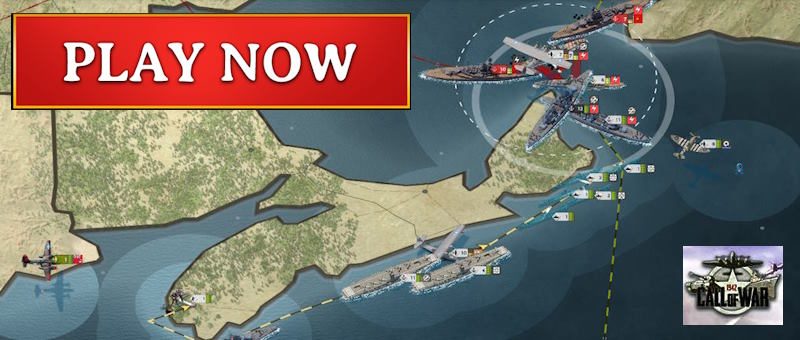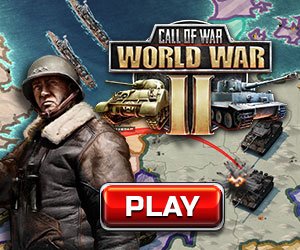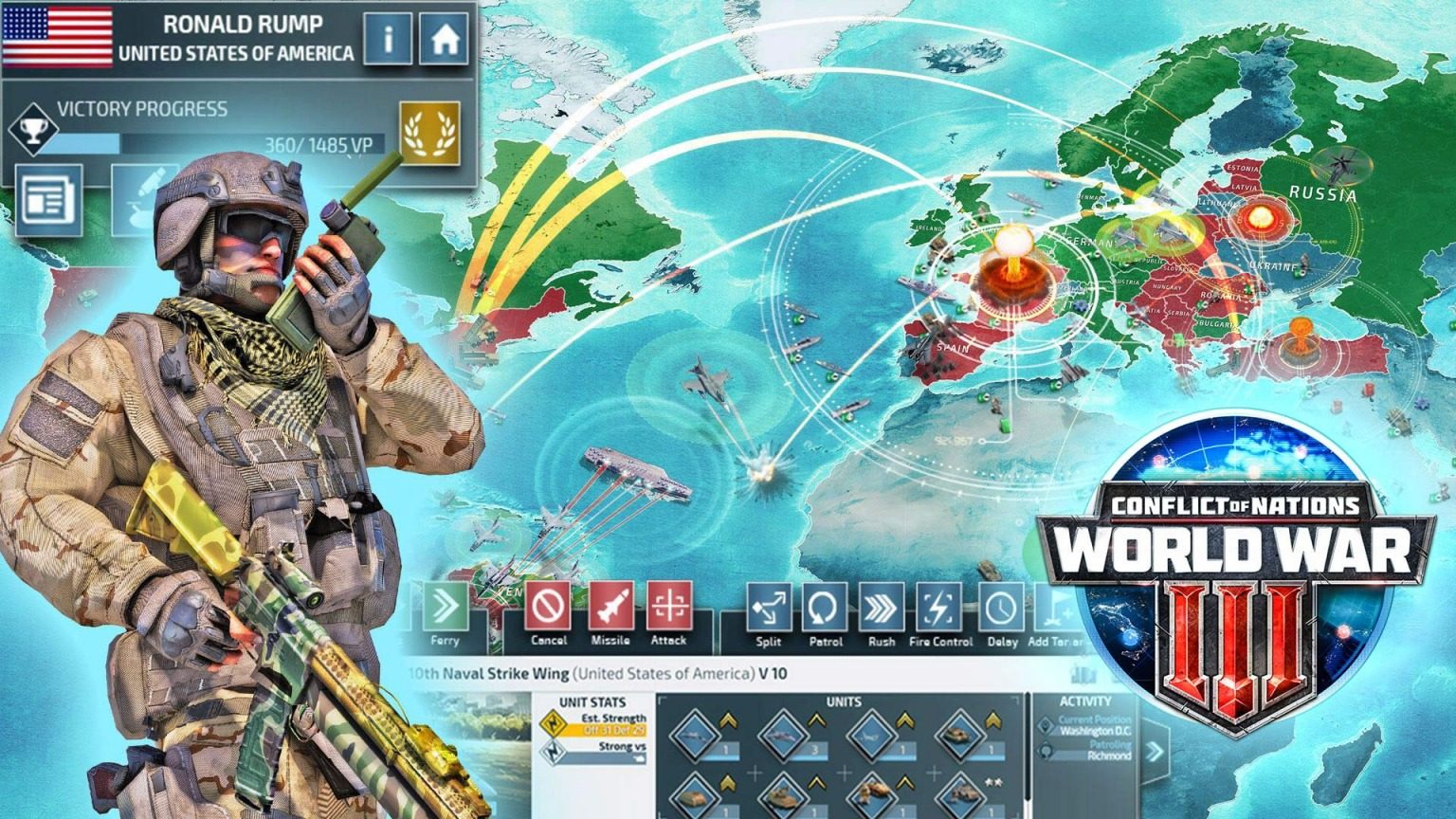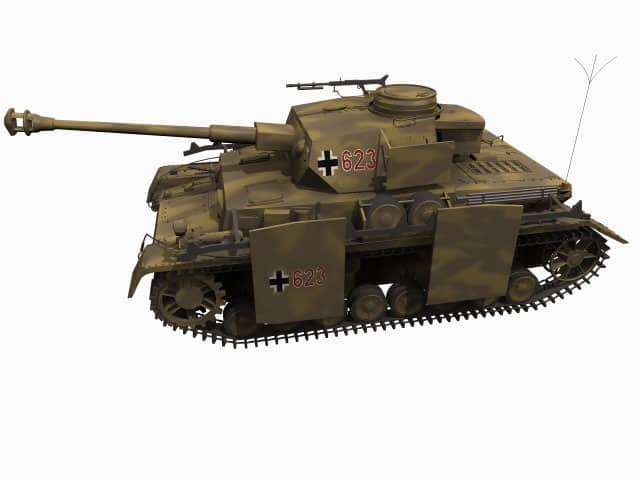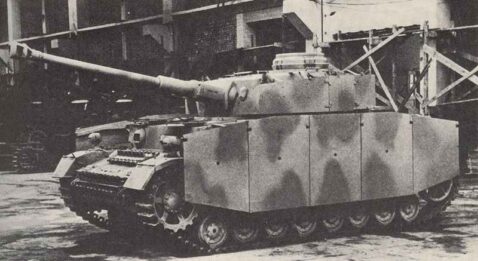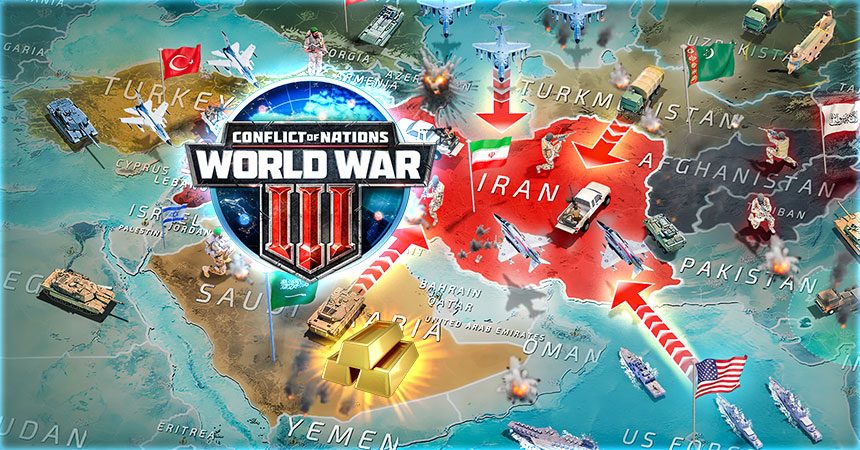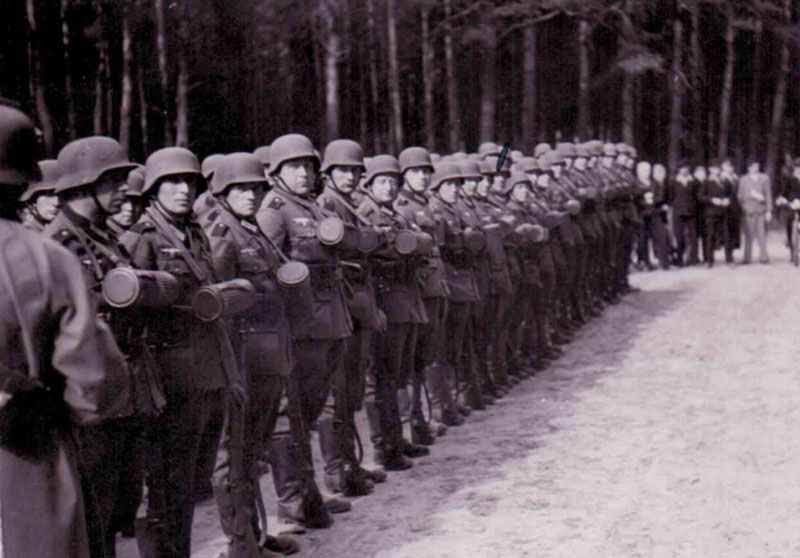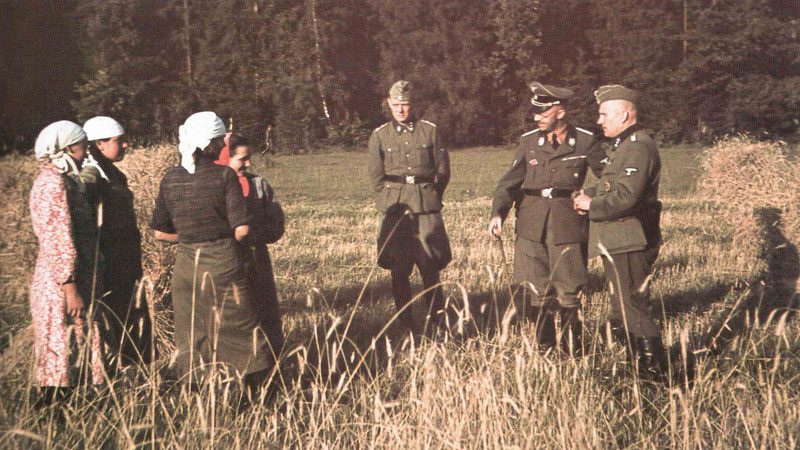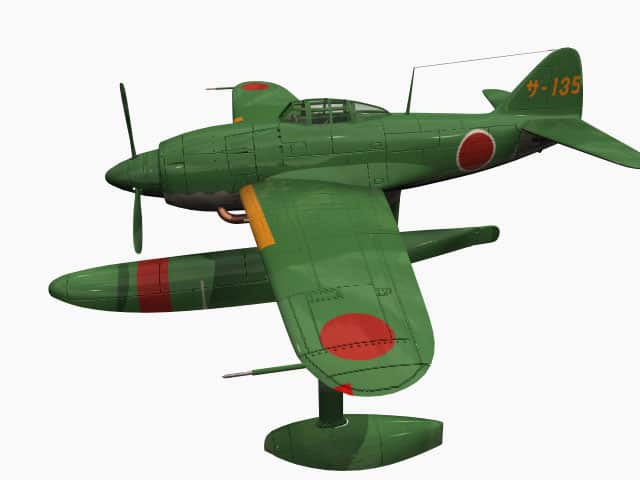German medium tank PzKpfw IV Ausf H.
History, development, service, specifications, statistics, pictures and 3D model of the Panzer IV variant.
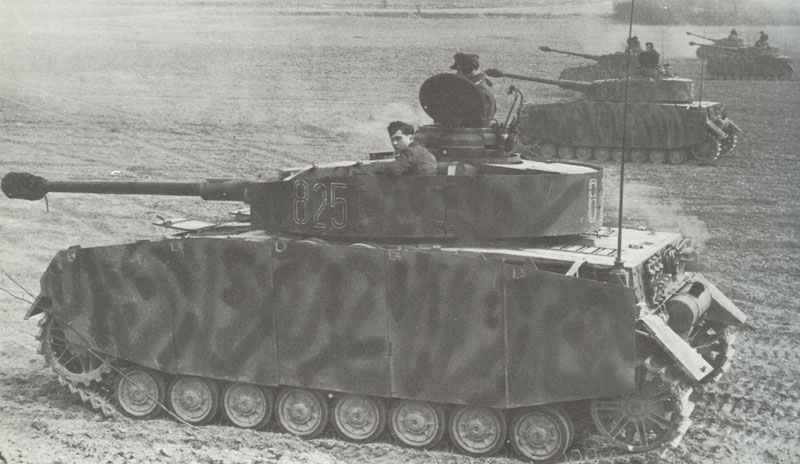
PzKpfw IV H
Table of Contents
Panzer IV Ausf H (SdKfz 161/2)
Type: German medium tank
The Panzerkampfwagen IV Ausführung H (PzKpfw IV Ausf.H), also known as the Panzer IV H, was a German medium tank used extensively during World War II. It was one of the later variants of the Panzer IV series, which was the most widely manufactured German tank of the war.
Overview of the Panzer IV Ausf.H
Armor: Increased frontal armor (80mm) compared to earlier models, providing better protection against enemy fire.
Main armament: A long-barreled 7.5 cm KwK 40 L/48 main gun, which was effective against most Allied tanks at medium and long ranges.
Secondary armament: Two 7.92 mm MG 34 machine guns for anti-infantry defense.
Engine: Maybach HL 120 TRM 300 HP engine, allowing a maximum speed of 40 km/h (25 mph) on roads.
Crew: Five members (commander, gunner, loader, driver, and radio operator/bow machine gunner).
The Panzer IV Ausf.H saw service on all fronts from mid-1943 until the end of the war in 1945. It was used in various roles, including direct combat, infantry support, and anti-tank operations. Despite being outclassed by later Allied tanks like the Soviet T-34-85 and IS-2, or the American M4 Sherman Easy Eight, the Panzer IV Ausf.H remained a capable and reliable vehicle when properly supported and employed.
History
Of the 3,935 Panzer IV Ausf H chassis produced, 3,774 were completed as PzKpfw IV, with 30 used for the first StuG IV assault guns and 130 for Assault tank Brummbär.
In November 1943, an attempt was made to alter the suspension to gain ground clearance. The experiment failed and the Panzer IV retained the same basic suspension from 1937 until the end of the war.
The basic change from the Panzer IV Ausf G was the SSG77 transmission fitted to the Ausf H. The frontal armour on the Ausf H evolved from 50 mm basic with 30 mm additional, to 80 mm basic, to 80 mm basic interlocked with the hull sides. Minor modifications, introduced during the production run of the Ausf H, included external air-filters, all-steel return rollers, a cupola mount for an antiaircraft machine gun, a new style idler, and the deletion of the side vision ports for the driver and radio operator.
From 1943, Panzer regiments in the Panzer divisions were to have one detachment equipped with Panzer IV and one detachment with Panthers. As a result of problems with the Panther tank, some Panzer divisions had a second detachment equipped with PzKpfw IV, while many had but a single detachment of four companies, each equipped with twenty-two PzKpfw IV, plus eight with the HO Company.
On 6 June 1944, most of the 748 Panzer IV with the nine Panzer divisions in France were Ausf H.
For comparison, average number of hits to knock out each type of tank:
Western Europe 1944-45:
Tank Type | Average number of hits | Average number of penetrations |
|---|---|---|
4.2 | 2.6 |
|
2.55 | 1.9 |
|
1.63 | 1.55 |
|
1.2 | 1.2 |
Users: Germany, Bulgaria, Croatia, Finland, Italy, Spain, Romania, Turkey, Hungary (for all variants).
Hypothetical 1v1 battle scenario between the German Panzer IV Ausf. H and the Soviet T-34/76 Model 1943
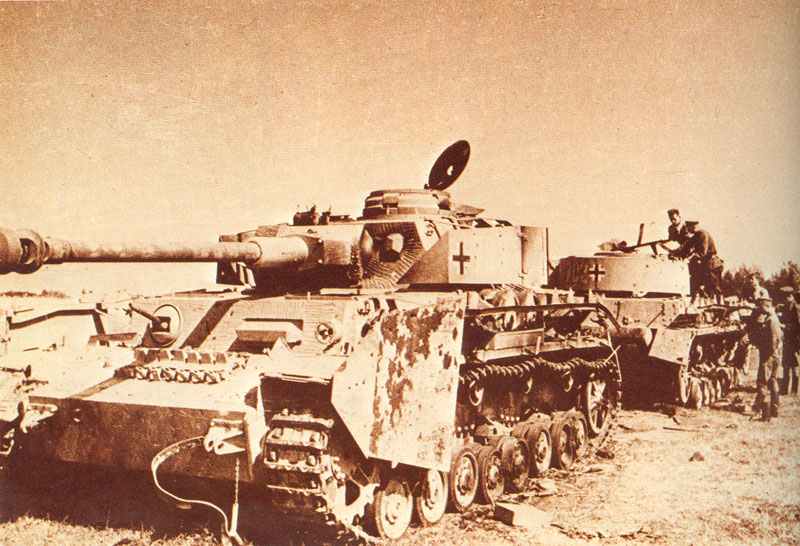
The T-34/76 Model 1943 was the last major 76 mm variant before the T-34/85.
We’ll look at three engagement ranges — close, medium, and long — and factor in armor, gun penetration, mobility, and crew training.
1. Technical Context
Panzer IV Ausf. H
– Main gun: 7.5 cm KwK 40 L/48 (Penetration: ~110 mm @ 100 m; ~80 mm @ 1,000 m)
– Armor: 80 mm frontal hull (vertical), 50–80 mm turret front, side skirts
– Speed: ~38–40 km/h
– Crew: Well-trained (in 1943, most German crews had extensive experience)
T-34/76 M43
– Main gun: 76.2 mm F-34 (Penetration: ~70–75 mm @ 100 m; ~60 mm @ 1,000 m)
– Armor: 75 mm frontal hull @ 60° slope (~120 mm effective), 52 mm turret front
– Speed: ~53–55 km/h
– Crew: Often less experienced than German counterparts in 1943
2. Engagement Scenarios
Close Range (≤500 m)
Panzer IV H advantage:
– KwK 40 L/48 can penetrate the T-34/76’s frontal armor, especially the turret, at this distance.
– German optics (Zeiss) are superior for accurate first shots.
T-34/76 disadvantage:
– The F-34 gun struggles to penetrate the Panzer IV H’s 80 mm frontal plate except at very close range and with lucky hits on weak spots (driver’s visor, lower glacis).
Likely outcome: Panzer IV H destroys T-34/76 in the first or second shot before being penetrated.
Medium Range (500–1,000 m)
Panzer IV H:
– Still capable of penetrating T-34/76’s frontal armor, though sloped hull may cause deflections.
– T-34/76:
– At 800–1,000 m, penetration against Panzer IV H’s front is very poor; would need to flank.
Likely outcome: Panzer IV H wins if it maintains frontal engagement; T-34/76 must maneuver for side shots.
Long Range (1,000–1,500 m)
Panzer IV H:
– Accuracy and penetration drop, but still has a better chance of scoring damaging hits than the T-34/76.
T-34/76:
– F-34 gun is ineffective against Panzer IV H’s frontal armor at this range.
Likely outcome: Panzer IV H dominates unless T-34/76 can use terrain to close the distance unnoticed.
3. Terrain & Tactics Factors
– Open terrain: Panzer IV H advantage — better optics and gun performance at range.
– Urban or forest terrain: T-34/76 has a better chance — can use speed and maneuverability to flank and hit side/rear armor.
– Crew experience: In 1943, German crews generally had the edge in training, communication, and gunnery.
4. Overall Hypothetical Result
– In a head-on duel, the Panzer IV Ausf. H would likely win over the T-34/76 M43 in most situations, especially at medium to long ranges.
– The T-34/76’s best chance is to use speed, concealment, and numbers to flank and attack from the sides or rear — which is exactly what Soviet doctrine emphasized.
Animated 3d model of Panzer IV H
Specifications for Panzer IV Ausf H
Specifications:
Panzer IV Ausf H | Specification |
|---|---|
Type | medium tank |
Engine | Maybach HL120TRM with 300 hp at 3,000 rpm |
Gearbox | 6 forward, 1 reverse |
Crew total | 5 |
Turret crew | 3 (with 360° Commanders cupola) |
Length | 7.02 m |
Width | 2.88 m |
Height | 2.68 m |
Weight | 25 tons |
Maximum speed | 23.6 mph |
Cross-country speed | 12 mph |
Fuel consumption per 100 miles | 400 litres on road, 600 litres cross-country |
Fuel | 470 litres |
Road radius | 110 miles |
Cross-country radius | 75 miles |
Vertical obstacle | 0.60 m |
Trench crossing | 2.30 m |
Fording depth | 0.80 m |
Turning circle | 6 m |
Gradient | 30 ° |
Armor:
Panzer IV Ausf H | mm | angle |
|---|---|---|
Turret front | 50 | 10 ° |
Turret side | 30 | 10 ° |
Turret rear | 30 | 15 ° |
Turret top | 15 | 84-90 ° |
Superstructure front | 80 | 10 ° |
Superstructure side | 30 | 0 ° |
Superstructure rear | 20 | 11 ° |
Superstructure top | 12 | 85-90 ° |
Hull front | 80 | 14 ° |
Hull side | 30 | 0 ° |
Hull rear | 20 | 8 ° |
Hull bottom | 10 | 90 ° |
Gun mantlet | 50 | 0-30 ° |
Armament and Equipment:
Panzer IV Ausf H | Specification |
|---|---|
Main armament | 7.5cm KwK40 L/48 |
Rounds | 87 |
Traverse | 360° (electric) |
Elevation | -8° to +20° |
Muzzle velocity Pzgr | 790 m/s |
Muzzle velocity Pzgr40 (available only in limited numbers) | 990 m/s |
Shell weight Pzgr | 6.8 kg |
Shell weight Pzgr40 | 4.1 kg |
Secondary armament | one 7.92mm MG34 coaxial to gun, one 7.92mm MG34 in front hull, one 7.92mm MG34 on commander's cupola, together 3,150 rounds |
Radio | FuG5 (2.5 miles range) |
Telescopic sight | TZF5f/1 (2.5 miles aiming) |
Penetration mm at 30° armor plates of 7.5cm KwK40 L/48:
Range | Pzgr | Pzgr40 (just limited numbers) |
|---|---|---|
Penetration 100 metres | 106 mm | 143 mm |
Penetration 500 metres | 96 mm | 120 mm |
Penetration 1000 metres | 85 mm | 97 mm |
Penetration 1500 metres | 74 mm | 77 mm |
Penetration 2000 metres | 64 mm | - |
Production:
Panzer IV Ausf H | data |
|---|---|
Production | from April 1943 to July 1944 |
Combat delivery | immediately after production delivery |
Price per tank | 115,962 RM (Ausf G) = $ 52,183 = £ 11,056 |
Total production figure | 3,774 |
Service statistics of all Panzer IV variants:
Year | Available | Production | Losses |
|---|---|---|---|
before 1939 | - | 115 | - |
1939 | 211 (1.9.) | 141 | ? |
1940 | 280 (10.5.) | 278 | ? |
1941 | 517 (1.6.) | 467 | 369 |
1942 | 513 (1.1.) | 994 | 502 |
1943 | 1,077 (1.1.) | 3,013 "2 | 352" |
1944 | 1,668 (1.1.) | 3,126 | 2,643 |
1945 | 1,684 (1.1) | 385 (Jan-March) | 287 (Jan.) |
Total | - | 7,419 | 6,153 |
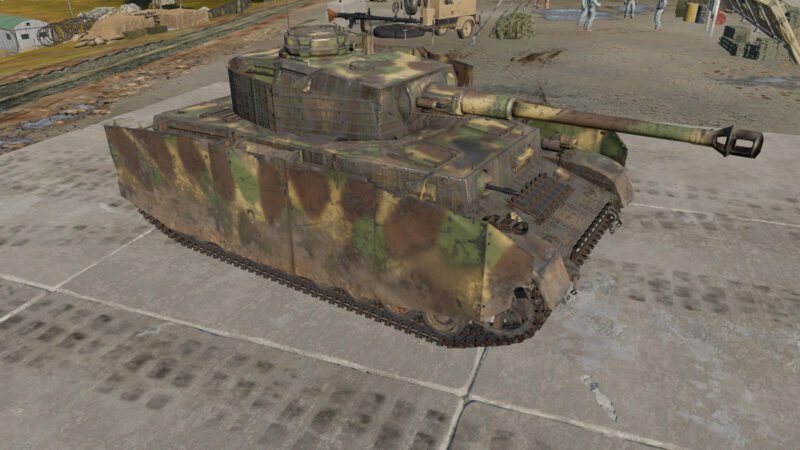
Video of Panzer IV H in action with computer games
Battle Rating (BR for short) 4.0 is one of the most popular ranges for German tanks in the F2P game War Thunder and usually records a stable victory rate of over 50% with relatively few ‘uptiers’ to higher ranges, as there are few German vehicles available on BR 4.7 and 5.0 for ‘Realistic Land Battles’. In addition, there is a wide range of vehicles, with some superior premium tanks as well.
The Panzer IV H has been on BR 4.0 in the German research tree for a short time now. This tank is characterized by the fast rate of fire of its accurate 7.5-cm KwK gun, which also has a very good penetrating power and where often one hit is enough to destroy the enemy.
This can be seen very well in the following video:
If you don’t know this F2P tank and plane game yet, you can download War Thunder here for free and will receive extra 50 Golden Eagles premium currency as well as a Rank I premium plane or tank:
References and literature
Kraftfahrzeuge und Panzer der Reichswehr, Wehrmacht und Bundeswehr (Werner Oswald)
Encyclopedia of German Tanks of World War Two (P.Chamberlain, H.L.Doyle)
Panzer und andere Kampffahrzeuge von 1916 bis heute (Christopher F. Foss, John F. Milsom, Colonel John Stafford Weeks, Captain Georffrey Tillotson, Richard M. Ogorkiewicz)
Panzerkampfwagen des 1. und 2. Weltkrieges (Andrew Kershaw)
Krieg der Panzer (Piekalkiewicz)
Operation Barbarossa: the Complete Organisational and Statistical Analysis, and Military Simulation, Volume I – IIIB (Nigel Askey)


